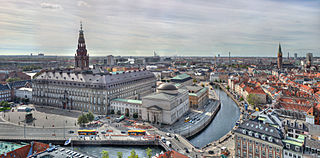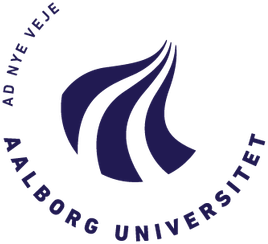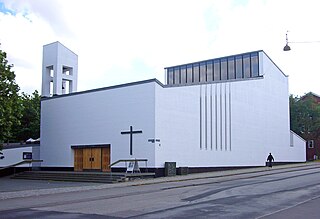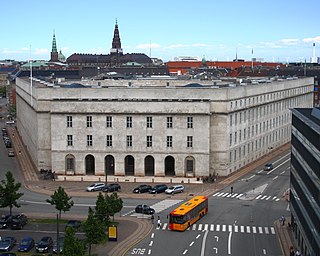Related Research Articles

Copenhagen is the capital and most populous city of Denmark, with a population of around 660,000 in the municipality and 1.4 million in the urban area. The city is on the islands of Zealand and Amager, separated from Malmö, Sweden, by the Øresund strait. The Øresund Bridge connects the two cities by rail and road.

Skandinaviska Enskilda Banken AB, abbreviated SEB, is a Swedish bank headquartered in Stockholm, Sweden. In Sweden and the Baltic countries, SEB has a full financial service offering. In Denmark, Finland, Norway, Germany, and the United Kingdom, the bank's operations are focused on corporate and investment banking services to corporate and institutional clients. The bank was founded in 1972 by the Swedish Wallenberg family, which is still SEB's largest shareholder through major investment company Investor AB. SEB is the largest Swedish bank by both market capitalisation and total assets.

Aalborg University (AAU) is an international public university with campuses in Aalborg, Esbjerg, and Copenhagen, Denmark. Founded in 1974, the university awards bachelor's degrees, master's degrees, and PhD degrees in a wide variety of subjects within humanities, social sciences, information technology, design, engineering, exact sciences, and medicine.

Christianshavn is a neighbourhood in Copenhagen, Denmark. Part of the Indre By District, it is located on several artificial islands between the islands of Zealand and Amager and separated from the rest of the city centre by the Inner Harbour. It was founded in the early 17th century by Christian IV as part of his extension of the fortifications of Copenhagen. Originally, it was laid out as an independent privileged merchant's town with inspiration from Dutch cities but it was soon incorporated into Copenhagen proper. Dominated by canals, it is the part of Copenhagen with the most nautical atmosphere.

The Danish Design Center (DDC) is Denmark's national center for design. Established in 1978, DDC is a non-profit foundation under the Danish Ministry of Business, Industry and Financial Affairs. The role of DDC is to promote the use of design in business and industry, help professionalise the design industry, and document, promote and brand Danish design in Denmark and abroad.

Schmidt Hammer Lassen (SHL) is an international architectural firm founded by a group of Danish architects in 1986 in Aarhus, Denmark. It currently has three offices in Copenhagen and Aarhus in Denmark, as well as Shanghai, China. In 2018, Schmidt Hammer Lassen became part of global architecture and design firm Perkins and Will.

Bjarke Bundgaard Ingels is a Danish architect, founder and creative partner of Bjarke Ingels Group (BIG).
Sustainia, formerly the Copenhagen Climate Council, is a global collaboration between international business and science founded by Erik Rasmussen founder of the leading independent think tank in Scandinavia, Monday Morning, based in Copenhagen. The councilors of the Copenhagen Climate Council have come together to create global awareness of the importance of the UN Climate Summit (COP15) in Copenhagen, December 2009, and to ensure technical and public support and assistance to global decision makers when agreeing on a new climate treaty to replace the Kyoto Protocol from 1997.
Henning Larsen Architects is an international architectural firm based in Copenhagen, Denmark. Founded in 1959 by Henning Larsen, it has around 750 employees.

Dorte Mandrup-Poulsen is a Danish architect. Founder and Creative Director of the architectural practice Dorte Mandrup Arkitekter A/S that has approximately 60 employees. The practice is based in Copenhagen, Denmark and is behind several internationally acclaimed buildings.

Bjarke Ingels Group, often referred to as BIG, is a Copenhagen, New York City, London, Barcelona, Shenzhen, Oslo and Los Angeles-based group of architects and designers operating within the fields of architecture, product and landscape design, engineering and planning. The office is currently involved in a large number of projects throughout Europe, North America, Asia and the Middle East. As of 2023, the company employs 700+ people.

The Green Climate Fund (GCF) is a fund for climate finance that was established within the framework of the United Nations Framework Convention on Climate Change (UNFCCC). Its objective is to assist developing countries with climate change adaptation and mitigation activities. The GFC is an operating entity of the financial mechanism of the UNFCCC. It is based in Incheon, South Korea. It is governed by a Board of 24 members and supported by a Secretariat.

8 House, also known as Big House, is a large mixed-use development built in the shape of a figure 8 on the southern perimeter of the new suburb of Ørestad in Copenhagen, Denmark. Designed by Bjarke Ingels, founding partner of the Bjarke Ingels Group (BIG), the bow-shaped building consists of 61,000 square metres of three different types of residential housing and 10,000 square metres of retail premises and offices. It is the largest private development ever undertaken in Denmark. Commissioned by Store Frederikslund Holding, Høpfner A/S and Danish Oil Company A/S in 2006, it is Ingels' third housing development in Ørestad, following VM Houses and Mountain Dwellings.

Utterslev is a neighbourhood in the Bispebjerg district of Copenhagen, Denmark. Utterslev is centered on Utterslev Torv and is most known for the Utterslev Mose marshland which straddles the border with Gladsaxe Municipality to the north.

The Copenhagen Police Headquarters building is located on Polititorvet southwest of the centre of Copenhagen, Denmark. Designed by Hack Kampmann and Aage Rafn in 1924 in the Neoclassical style, often referred to as Nordic Classicism, it was completed in 1924.

Industriens Hus is the home of the Confederation of Danish Industries. The building is located at the corner of H. C. Andersens Boulevard and Vesterbrogade, opposite the City Hall Square, in Copenhagen, Denmark. It also contains a showroom for green technologies, House of Green, as well as a series of two-storey flagship stores and restaurants on Vesterbrogade.

Henrik Bjørn Valeur is a Danish architect-urbanist, founder and creative director of UiD (Denmark) and UiD Shanghai Co., Ltd (China), curator of CO-EVOLUTION: Danish/Chinese Collaboration on Sustainable Urban Development in China, which was awarded the Golden Lion at the Venice Biennale of Architecture in 2006, and author of the book India: the Urban Transition - a Case Study of Development Urbanism (2014), which is based on his experiences teaching, researching and practicing in India.

The Danish National Exhibition of 1909 or The National Exhibition in Aarhus 1909 was an industry, crafts and culture exhibition held in Aarhus, Denmark in 1909 from 18 May to 3 October. The exhibition displayed some 1850 individual works by architects, artists, craftsmen and businesses and attracted 650.000 visitors. The project was a large undertaking for the city with long-lasting effects on cultural institutions and short-term economic problems. The exhibition fairgrounds was named The white City based on the architectural expression chosen by the leading architect Anton Rosen.

Erland Kolding Nielsen was Director General and CEO of The Danish Royal Library.

Climate change education (CCE) is education that aims to address and develop effective responses to climate change. It helps learners understand the causes and consequences of climate change, prepares them to live with the impacts of climate change and empowers learners to take appropriate actions to adopt more sustainable lifestyles. Climate change and climate change education are global challenges that can be anchored in the curriculum in order to provide local learning and widen up mindset shits on how climate change can be mitigated. In such as case CCE is more than climate change literacy but understanding ways of dealing with climate